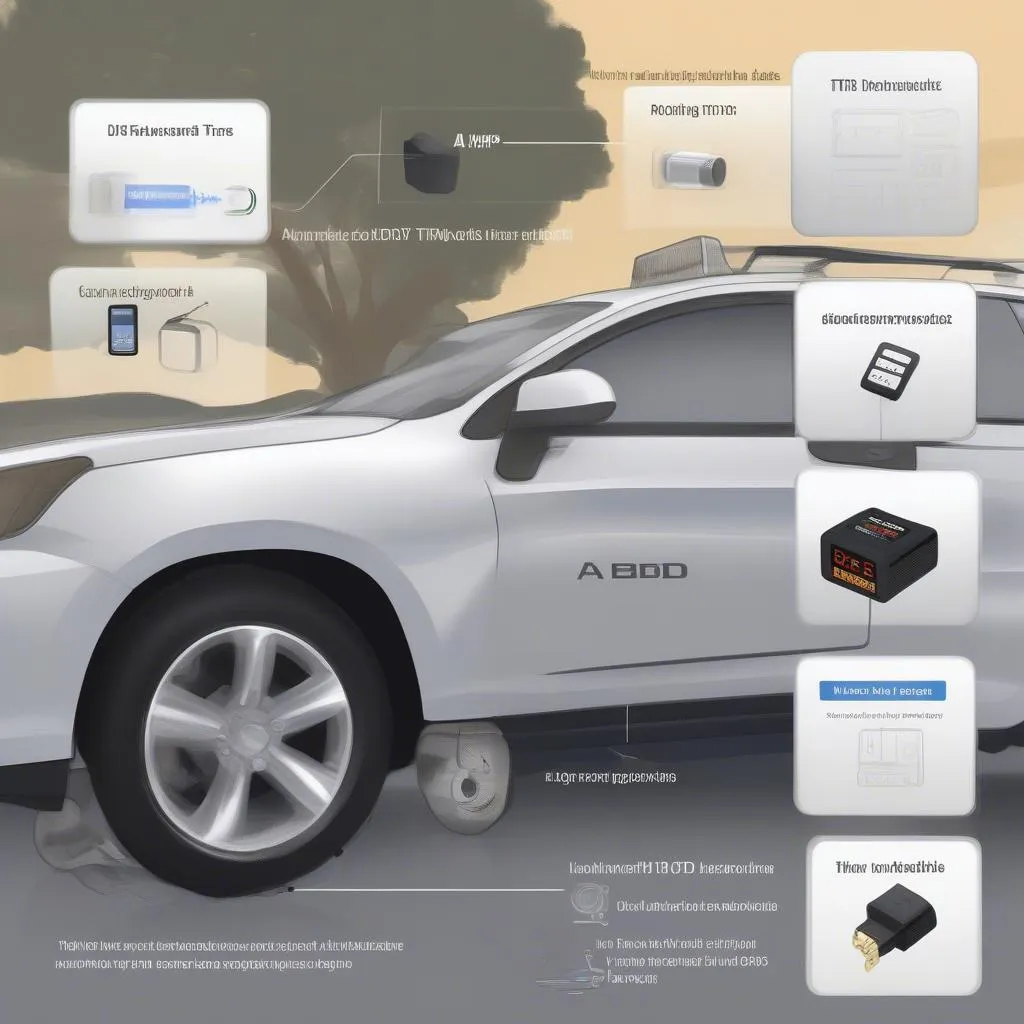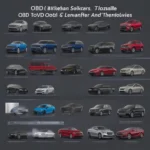OBD2 Bluetooth TPMS systems have revolutionized the way we monitor tire pressure, offering real-time data and enhanced safety features directly to your smartphone. These systems are a significant step up from traditional indirect TPMS found in many vehicles, providing more accurate and detailed information about your tires.
Understanding OBD2 Bluetooth TPMS
Before diving into the advantages of OBD2 Bluetooth TPMS, it’s essential to grasp how this technology differs from conventional tire pressure monitoring systems.
-
Traditional TPMS: These systems rely on your car’s ABS sensors to detect variations in wheel rotation speed, indicating potential tire pressure loss. However, these systems are less precise and only trigger a warning light when a significant pressure difference exists.
-
OBD2 Bluetooth TPMS: This advanced system utilizes individual sensors installed on each tire valve stem. These sensors continuously transmit real-time tire pressure and temperature data wirelessly to a receiver, which then relays the information to your smartphone or dedicated display device via Bluetooth.
Advantages of Choosing OBD2 Bluetooth TPMS
The appeal of OBD2 Bluetooth TPMS lies in its ability to provide drivers with a comprehensive and convenient solution for tire pressure monitoring. Here’s why an increasing number of car enthusiasts and safety-conscious drivers are choosing this technology:
-
Real-time Accuracy: Obtain precise readings for each tire, ensuring optimal tire pressure for fuel efficiency, tire lifespan, and vehicle handling.
-
Early Detection: Identify even minor pressure fluctuations before they escalate into significant issues, allowing you to address potential problems proactively.
-
Enhanced Safety: Real-time monitoring enhances safety by alerting you to tire pressure changes that could impact braking, handling, or even lead to blowouts.
-
Extended Tire Life: Maintaining optimal tire pressure minimizes wear and tear, extending the lifespan of your tires and saving you money in the long run.
-
Improved Fuel Economy: Underinflated tires can significantly decrease fuel efficiency. OBD2 Bluetooth TPMS helps ensure proper inflation, maximizing your gas mileage.
Choosing and Installing an OBD2 Bluetooth TPMS
Selecting the right OBD2 Bluetooth TPMS system and installing it correctly are crucial for optimal performance. Consider these factors:
- Sensor Type: Choose between internal sensors, installed inside the tire, or external sensors, screwed onto the valve stems.
- Display Options: Decide whether you prefer a dedicated display unit or an app-based system that utilizes your smartphone.
- Additional Features: Some systems offer extras like temperature warnings, pressure history logs, and customizable alerts.
Installation is typically straightforward:
- Install Sensors: Replace your existing valve caps with the TPMS sensors.
- Connect Receiver: Plug the OBD2 receiver into your vehicle’s OBD2 port.
- Pair with Device: Use Bluetooth to pair the system with your chosen display device.
- Calibrate (if required): Some systems may require calibration for accurate readings.
Common Questions About OBD2 Bluetooth TPMS
Q: Is OBD2 Bluetooth TPMS compatible with my car?
A: Most vehicles manufactured after 1996 with an OBD2 port are compatible. However, checking your car’s compatibility with the specific TPMS system you choose is always recommended.
Q: Can I install an OBD2 Bluetooth TPMS system myself?
A: Yes, installation is generally user-friendly and can be done at home. However, if you’re uncomfortable with the process, a mechanic can assist.
Q: How long do the batteries in the sensors last?
A: Sensor batteries typically last between 3 to 5 years, depending on usage and environmental factors.
Conclusion: Enhancing Safety and Performance
Investing in an OBD2 Bluetooth TPMS system is a wise decision for any driver seeking improved safety, enhanced vehicle performance, and maximized tire longevity. With real-time monitoring, early detection, and smartphone convenience, this technology empowers you to stay informed and in control of your tire health, ensuring a smoother and more confident driving experience.
Need assistance in choosing the right OBD2 scanner or have questions about automotive diagnostics? Contact us via WhatsApp: +1(641)206-8880, or email us at [email protected]. We’re available 24/7 to offer expert guidance and support!


